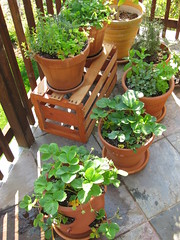
![]() Photo credit: thomas pix
Photo credit: thomas pix
Watering
The great thing about containers is that they can easily be moved in and out of the sun or rain. You can even buy wheels for the bottom of the containers! Some plants do better in the elements then others, but moving them undercover when its raining is generally a good idea. When watering your plants, water close to the roots and try to avoid getting the leaves and vegetables wet. When you first plant seeds, water gently so the seeds won’t get uprooted and wash away.
Insects
Not all insects are bad in the garden. Knowing which bugs to keep around can actually improve your vegetables. Garden-friendly insects include bees (to pollinate plants), ladybugs, dragonflies and spiders (who will eat insects you don’t want) and earthworms. Not-so-friendly critters include slugs and snails, and aphids. You can also make your own organic “pesticide†by pouring a little liquid soap on aphids, which will kill them. Even better, introducing ladybugs will solve the problem.
In many cases, simply spraying aphids with the hose will wash them away. Slugs can usually be deterred by a ring of eggshells or pine needles around the plants that they cannot cross. To kill slugs, beer and salt both work well.
Recommended Comments
There are no comments to display.
Join the conversation
You can post now and register later. If you have an account, sign in now to post with your account.